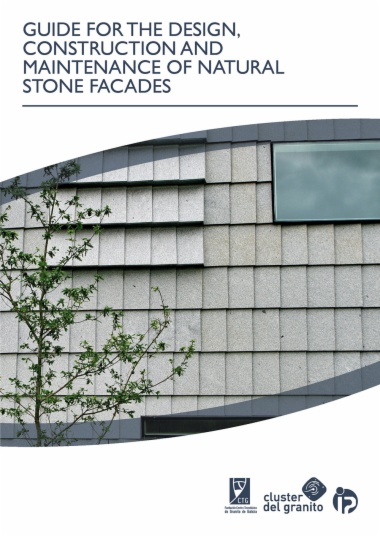Building facade cladding makes up constructive systems in which natural stone, as well as providing its exceptional aesthetic value, gives many of its features. This e-book explains the regulations about natural stone in facade projects, calculation and execution, and quality controls. Likewise, the main methods and conditions for its maintenance, cleaning and conservation are defined.
- Index
- PRESENTATION
- INTRODUCTION
- 1. Stone for facade construction
- 1.1. Brief historic overview
- 1.2. Natural stone designation
- 1.3. Natural stone varieties
- 1.4. Surface finishes
- 1.5. Stone advantages for facade construction
- 1.6. Formats used in facades
- 1.6.1. Slabs for cladding
- 1.6.2. Modular tiles
- 2. Natural stone controls
- 2.1. CE marking
- 2.2. Control requirements
- 2.2.1. Size requirements
- 2.2.2. Flexural strength
- 2.2.3. Anchor strength
- 2.2.4. Water absorption at atmospheric pressure
- 2.2.5. Coefficient of water absorption by capillarity
- 2.2.6. Frost resistance
- 2.2.7. Resistance to ageing by thermal shock
- 2.2.8. Sensitivity to changes in appearance produced by thermal cycles
- 2.2.9. Marble resistance to thermal and moisture cycles
- 2.2.10. Resistance to the impact of hard objects
- 2.2.11. Bulk density and open porosity determination
- 2.2.12. Petrographic denomination
- 2.2.13. Fire performance
- 2.2.14. Soluble salt crystalisation
- 2.2.15. Appearance
- 3. Legislation and regulations
- 3.1. Building Management Law (LOE)
- 3.2. Spanish Technical Building Code (CTE)
- 3.3. EOTA’s guideline draft
- 3.4. Technical Approval Certificate (DIT)
- 3.5. Fitness for Use Document (DAU)
- 3.6. Other regulations
- 4. The facade project
- 4.1. Stone selection
- 4.2. Claddings without air space
- 4.2.1. Claddings fixed with adhesives
- 4.2.2. Claddings fixed with mortar and holding rods
- 4.2.3. Claddings with mechanical fixing and backfilling with bastard mortar
- 4.3. Claddings with mechanical fixing: ventilated facade
- 4.3.1. Support
- 4.3.2. Insulation
- 4.3.3. Air space
- 4.3.4. Anchors
- 4.3.5. Joints
- 4.4. Watertightness
- 4.4.1. Watertightness in ventilated facades
- 4.4.2. Impermeability degree
- 4.5. Stability with fire
- 4.6. Acoustic conditions
- 4.6.1. Soundproofing of mixed elements
- 4.6.2. Effect of the facade shape in soundproofing to airborne noise
- 4.6.3. Windows and their requirements in the architectural project
- 5. Facade calculation
- 5.1. Actions on cladding
- 5.1.1. Own weight
- 5.1.2. Wind pressure determination
- 5.1.3. Seismic actions determination
- 5.2. Load distribution in the anchors for their selection
- 5.2.1. Load distribution in horizontal joint
- 5.2.2. Load distribution in vertical joint
- 5.3. Slab thickness calculation
- 5.3.1. Flexural stresses on the slab
- 5.3.2. Cutting stresses on the slab in the anchor point
- 5.3.3. Thickness required to support the impact actions
- 6. Facade execution
- 6.1. Setting-up general criteria
- 6.2. Storage at worksite
- 6.3. Facades with natural stone claddings without air space.
- 6.3.1. Claddings fixed with adhesives
- 6.3.2. Claddings fixed with mortar/adhesive and holding rods
- 6.3.3. Claddings with mechanical fixing and backfilling
- 6.4. Ventilated facade
- 6.4.1. Setting out
- 6.4.2. Square laying
- 6.4.3. Metal section laying
- 6.4.4. Thermal insulation laying
- 6.4.5. Air space laying
- 6.4.6. Fixing of the anchor system to the support
- 6.4.7. Execution of singular points
- 7. Quality control
- 7.1. Norms
- 7.1.1. Spanish Technical Building Code (CTE)
- 7.1.2. Products subject to the Construction Products Directive (CPD)
- 7.2. Controls prior to delivery of stone
- 7.3. Receipt controls at worksite
- 7.4. Execution controls
- 8. Maintenance, cleaning and conservation
- 8.1. Maintenance and conservation guidelines
- 8.2. Guidelines and typology of cleaning methods
- 9. Drawing up budgets
- BIBLIOGRAPHIC REFERENCES

